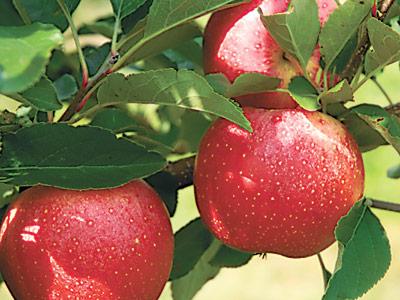Seasons by the Sea: An Apple a Day

In the 1830s, when the temperance movement was flourishing in America, fanatic teetotalers took up axes and flailed away at whole orchards of apple trees. With no thought for the delights of warm apple pie or syrupy baked apples or roast pork with applesauce, they were bent on eliminating the evil of hard cider.
From colonial times, cider had been the most popular drink in New England. Not only was it served at meals and offered to all guests, it was even used as barter. An 1805 diary entry recorded the following transaction: “one-half barrel of cider for Mary’s schooling.”
Well, let’s all be grateful that these overzealous fanatics failed to destroy one of our most valuable, delicious, and nutritious fruits, the Malus pumila.
Apples are one of the first fruits to have been cultivated, and are now the most important fruit in Europe, North America, and temperate regions in both the Northern and Southern hemispheres. There are now close to 8,000 named varieties. The sweet, crunchy fruit we are familiar with is nothing like its ancestor, the tiny, sour crabapple.
From the beginning, we have been enamored of fruit, and apples in particular. Besides milk and honey, fruit is “nature’s only pleasure-laden natural food,” according to Mitch Lynd of the Midwest Apple Improvement Association. Throughout history, apples have been associated with love, beauty, luck, health, comfort, pleasure, wisdom, temptation, sensuality, virility, and fertility. In Greek mythology, the romantic and sexual connotations of the apple may even be the reason it has become dessert at the end of a meal. Besides aiding digestion, it was believed to be a powerful aphrodisiac for the pleasures to follow.
Taste in apples varies around the world. In England they are divided into two distinct categories, apples for eating and apples for cooking. Harold McGee’s “On Food and Cooking: The Science and Lore of the Kitchen” divides apples more specifically into four categories. Cider apples are high-acid fruits rich in astringent tannins, perfect for making that naughty, naughty hard cider. Dessert or eating apples are crisp and juicy and have a pleasing balance between sour and sweet. Cooking apples are distinctly tart when raw, well-balanced when cooked, and have a firm flesh that holds its shape when cooked. Dual purpose apples are good for eating raw or cooking.
One of my favorite activities this time of year is visiting the Milk Pail in Watermill where you can sample different varieties. There are also helpful signs to guide you through the choices between Macoun, Gravensteins, Mutsus, Cortlands, Pippins, and so on. There are also plenty of pick-your-own orchards, a fun activity for small children because it takes approximately three and a half minutes to fill a bushel basket!
Happily, like heirloom tomatoes, there has been a revival of interest in antique and heirloom varieties of apples. We now realize that a beautiful apple does not necessarily mean it tastes best. Some are russet and some are lumpy but still delicious!
Try Cortland apples for fruit salads; their flesh is slow to brown. McIntosh apples have a soft, juicy texture, a nice combination of tart and sweet, and are good for cooking or eating. Granny Smiths, distinctive for their green color, are crisp, juicy, tart, and are my favorite for pies.
Last but not least, apples are the perfect, portable snack, available year round, and good for your heart, digestion, lungs, and bones.
Click for Recipes
